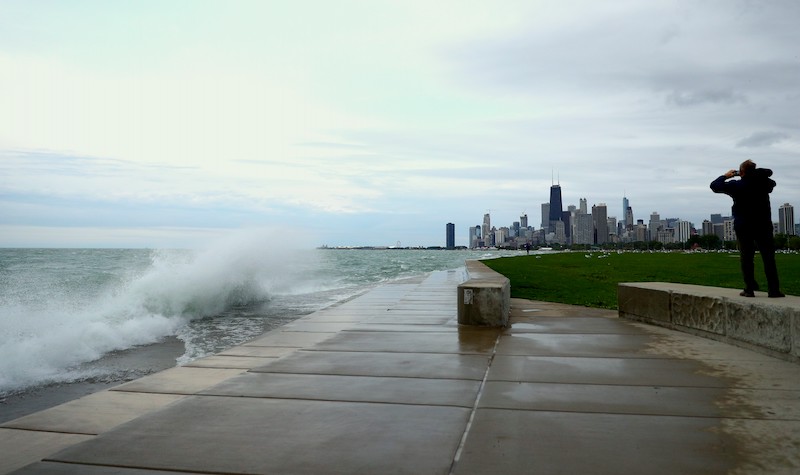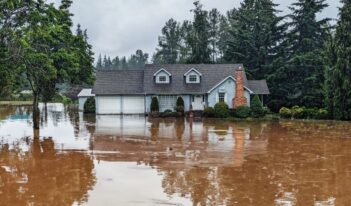
Historic water levels across the Great Lakes region present state regulators with significant challenges.
Water levels across Lake Michigan and Lake Huron reached near-historic levels in 2020, with threats to beaches creating an urgent need to respond. Federal and state regulators across the Great Lakes region have their hands full.
The record water levels across the Great Lakes region are dangerous because they expedite the natural processes of coastal erosion. Scientists attribute the rising water levels to human-driven climate change.
Last year, this erosion was directly responsible for the destruction of coastal homes, the crumbling of a historic Michigan highway, and the disappearance of numerous beaches. An alliance of Great Lakes mayors estimated that high water levels, erosion, and flooding accounted for about $500 million worth of damage between 2019 and 2020 to cities along the Great Lakes coastline.
This coast covers eight states and spans 4,530 miles—more than both the U.S. Pacific and Atlantic coastlines combined. But late last year, the federal government halted funding for the $12 million U.S. Army Corps of Engineers’ Great Lakes Coastal Resiliency Study. The study would have examined the long-term coastal risks across the Great Lakes region.
In early December 2020, however, the U.S. Senate demonstrated its commitment to the issue. In a rare moment of bipartisanship, the Safeguarding Tomorrow through Ongoing Risk Mitigation (STORM) Act passed the Senate with strong support. The bill became law in January 2021 and permits the Federal Emergency Management Agency to grant local governments loans for erosion mitigation projects.
But another challenge persists—only about 20 percent of the U.S. Great Lakes coastline is publicly owned, and the STORM Act does not provide direct relief to private property owners facing coastline erosion.
Many property owners have turned to state environmental regulators. Across the Midwest, these regulators have been inundated with requests for coastline protection permits. Approved permits allow property owners to construct seawalls along their coastlines.
Seawalls are “near-vertical structures” built out “of timber, concrete, steel, or aluminum.” They mitigate the sliding of land toward the water. With such a vast amount of coastline dominated by private ownership, seawalls have emerged as the primary response to Great Lakes coastal erosion.
Still, state regulators are staying busy.
The Michigan Department of Environment, Great Lakes, and Energy, for example, granted 2,284 permits for the 2019 to 2020 year—triple the amount granted the previous year. This surge of applications has led regulators to expedite the review process, bringing down the average review period of 60 to 90 days to just 10. In most cases, both the state regulator and U.S. Army Corps of Engineers must approve these applications.
But a problem remains: The seawall “solution” can actually worsen the erosion problem. Seawalls can help protect property in the short term—but contribute to greater coastal erosion in the long term.
Seawalls direct wave energy sideways toward neighboring property, creating new erosion where none may have previously existed. Seawalls also direct energy downward. This energy “scoops out the lake bottom,” which creates a scour—a removal “of granular bed material in the vicinity of coastal structures.” Over time, the scour may carve toward the shore, collapsing the entire seawall.
The permit process seeks to ensure that only residents on the brink of property damage receive approval to construct a seawall. Some policymakers however, such as Michigan State Senator Roger Victory, want to remove this safeguard. In early 2020, he remarked that residents trying to protect their property should not face “red tape.”
Senator Victory proposed a bill that would allow Michigan residents to bypass the traditional permit process and temporarily install seawall structures without state approval. The bill narrowly passed the state senate early last year, and has moved closer to house approval in recent months.
The Wisconsin Department of Natural Resources already approved such a measure in 2019. Property owners can now commence work on seawalls or other emergency coastal protection measures while their applications are still pending. Property owners submitted approximately 280 emergency certification permits to the agency by August 2020—a marked increase from the 134 received in 2019.
In some instances, the threat of erosion and rising tides may require immediate attention. Waiting a few days may be too long. Even so, are state leaders willing to remove the regulatory process for a limited number of such requests?
The answer seems to be “yes.”
The start of 2021 has already brought some good news, however. Early data reveal that water levels across the Great Lakes are beginning to dip from the record highs of 2020.
Even so, state environmental regulators could face another busy year.



